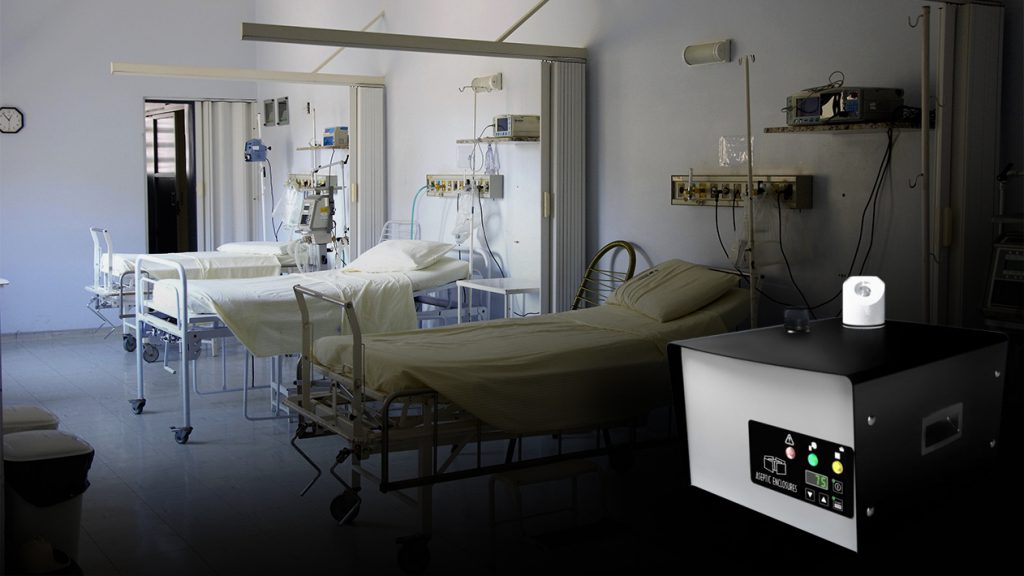The emergence of multiresistant bacterial strains as agents of healthcare-related infection in hospitals has prompted a review of the control techniques, with an added emphasis on preventive measures, namely good clinical practices, antimicrobial stewardship, and appropriate environmental cleaning. The latter item is about the choice of an appropriate disinfectant as a critical role due to the difficulties often encountered in obtaining a complete eradication of environmental contaminations and reservoirs of pathogens.
The disinfection of hospital surfaces is a complex operation aimed at reducing the pathogenic microorganism load. An ideal disinfectant must be safe for human health. It may have a good stability in the environment and may be free of toxic activity.
Hydrogen peroxide is a versatile disinfectant since it can be used in several environmental matrices: air, water, wastewater, surfaces, soil, etc. It may be used in combination with other agents increasing the disinfection times. Hydrogen peroxide is more oxidizing than chlorine and chlorine dioxide. The disinfection mechanism is based on the release of oxygen free radicals, which cause genomic damage in bacterial cells.
Hydrogen peroxide in the vaporized form (HPV) is used for surface disinfection. It may be combined with higher or lower concentrations of silver ions. The bactericidal activity of hydrogen peroxide was studied in several in vitro tests. In 1987, a Californian working group published data related to the ability of hydrogen peroxide (30–100 ppm) to cause DNA damage in different Escherichia coli strains, mostly in oxyR and Son of Sevenless (SOS) regions, involved in the shelter of genomic damage caused by oxidizing agents.
Several studies evaluated the role of HPV in environments contaminated by multidrug-resistant Acinetobacter baumannii strains and methicillin-resistant Staphylococcus aureus strains. Experimental tests were directly performed in the hospital setting following the death of 2 out of 13 patients infected by multidrug-resistant Acinetobacter baumannii. The same strain was isolated in 7% of the sampled surfaces. After cleaning, the investigated room was subjected to HPV treatment (240 ppm for 8 h). After disinfection, the same microorganism was not detected anymore.
Several encouraging results have been obtained on MDR Acinetobacter baumannii and Clostridium difficile. In fact, HPV disinfection allowed a 91% reduction of these resistant types of bacterial strains.
Encouraging results obtained on Enterobacteriaceae (in vitro also on Klebsiella pneumoniae) suggest the possible application of this system in the hospital environment as a new frontier in the prevention and control of healthcare-related infections, mostly in endemic and prolonged infective conditions.
One such Hydrogen Peroxide vaporizer is the “ViTralizer”, recently popular for its proven track record of eliminating the Coronavirus from all types of surfaces in any type of setting. Our goal is to improve all hospital infection control practices, including cleaning and disinfection, as well as behavioral and environmental practices, to the point where preventing the spread of these multiple-drug-resistant organisms also minimizes the chances of patients becoming infected and improves their chances of recovery.
The ViTralizer has been designed to ensure maximum safety, suitable for its commercial or household applications. The unit is equipped with user-friendly components making its operation really simple. Simply fill the reservoir (about 1 qt), set the room size, push start and leave the room. The “ViTralizer” is capable of sanitizing over 17,000 cubic feet (2,125 Square Feet @ 8 ft ceilings) in one run.
In less than an hour, people can safely return to the now sanitized area. If you need more space covered, just move the machine to a different location and run it again.
It’s that easy.
To request before and after Micro laboratory testing results, please call 800-418-9289.
* The studies cited were published by Michele Totaro, Beatrice Casini , Sara Profeti, Benedetta Tuvo, Gaetano Privitera and Angelo Baggiani *Department of Translational Research and the New Technologies in Medicine and Surgery, University of Pisa,56123 Pisa, Italy© 2020 by the authors. Licensee MDPI, Basel, Switzerland. This article is an open access article distributed under the terms and conditions of the Creative Commons Attribution (CC BY) license (http://creativecommons.org/licenses/by/4.0/).
